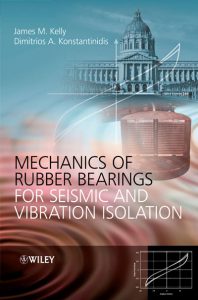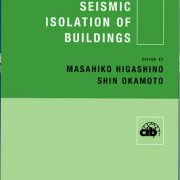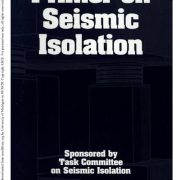MECHANICS OF RUBBER BEARINGS
FOR SEISMIC AND VIBRATION ISOLATION
The multilayer rubber bearing is an apparently simple device that is used in a widevariety of industries that include civil, mechanical and automotive engineering. It is soubiquitous that it may be difficult to believe that it is a relatively recent development,having been used for only about fifty years. The idea of reinforcing rubber blocks bythin steel plates was first proposed by the famous French engineer Eug`ene Freyssinet(1879–1962). He recognized that the vertical capacity of a rubber pad was inverselyproportional to its thickness, while its horizontal flexibility was directly proportional toit. He is best known for the development of prestressed concrete and for the discovery ofcreep in concrete.
It is possible that his invention of the reinforced rubber pad
It is possible that his invention of the reinforced rubber pad was drivenby the need to accommodate the shrinkage of the deck due to creep and prestress load,while sustaining the weight of a prestressed bridge deck. He obtained a French patentin 1954 for his invention, and within a few years the concept was adopted worldwideand led to the extraordinary variety of applications in which multilayer rubber bearingsare used today.These reinforced rubber bearings in their various forms are a source of fascinatingproblems in solid mechanics. It is the combination of vertical stiffness and horizontalflexibility, achieved by reinforcing the rubber by thin steel plates perpendicular to thevertical load, that enables them to be used in many applications, including the seismicprotection of buildings and bridges and the vibration isolation of buildings and ma-chinery.
The horizontal, vertical, and bending stiffnesses
The horizontal, vertical, and bending stiffnesses are important to the designof bearings for these applications and for predicting the buckling load, the interactionbetween vertical load and horizontal stiffness, and the dynamic response of structuresand equipment mounted on the bearings.We will cover the theory for vertical stiffness in Chapter 2 and for bending stiffnessin Chapter 3. Some of the results in these two chapters are new. The results of Chap-ters 2 and 3 are used to predict the stresses in the steel reinforcing plates in Chapter 4.The analysis used to calculate these stresses is new to this text and was only recentlydeveloped by the authors. Also new and original to this text is the development of atheory for these stresses when the effect of the bulk compressibility of the rubber isincluded, which is necessary for seismic isolation bearings, but usually not for vibra-tion isolation bearings. In Chapter 5 we study the stability of these bearings, showing
Detials:
| عنوان |
MECHANICS OF RUBBER BEARINGS |
| نویسنده | |
| زبان | English |
| Size | 26.3 MB |
| Download Method | مستقیم |
| Download Links | Download MECHANICS OF RUBBER BEARINGS |




 Response Control and Seismic Isolation of Buildings
Response Control and Seismic Isolation of Buildings
 تهران، شهرک غرب، بلوار خوردین، بلوار شریفی، توحید 4، پلاک 6، واحد 111
تهران، شهرک غرب، بلوار خوردین، بلوار شریفی، توحید 4، پلاک 6، واحد 111

